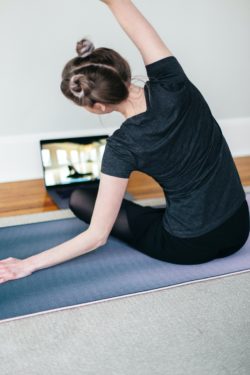Coerced leisure: New perspectives on free time during the COVID-19 pandemic

Online Learning (credit: Nick Morrison, Unsplash)
In this post, Marta Soligo explores how the COVID-19 pandemic has affected leisure patterns and the very idea of free time.
At the beginning of every semester, when I ask my Sociology of Leisure students, “What is leisure?” the answer is always the same, “leisure is free time.” Now that our class has moved online due to the campus closure, I asked them to rethink that question while taking into consideration the COVID-19 situation. With people forced to not leave their houses, questions arise in terms of framing a context where coerced free time—and leisure, some argue— becomes the rule. Thus, what is leisure time during the COVID-19 pandemic?
Encyclopedia Britannica defines leisure as “freedom provided by the cessation of coerced activities, particularly time free from disagreeable work or duties.” Lately, when I hear people say that they would never have thought of hating being at home with too much free time, my mind goes to J. R. Kelly’s definition of leisure as “an activity chosen in relative freedom for its qualities of satisfaction.” While in some parts of the world residents are still authorized to undertake outdoor activities in proximity to their houses, the takeover of internet-based initiatives is undeniable. In the past few days, I was struck by the creativity of my Instagram contacts, who all of the sudden showed unexpected dancing, painting, and baking skills. Although the idea of discovering your inner talents sounds fun and seems to reflect Kelly’s definition of “quality of satisfaction,” we cannot ignore the complex moment we are living in. Undertaking those leisurely activities means keeping our minds busy in one of the most challenging moments in contemporary history.
In cultural studies, the notion of leisure as a tool for (mass) distraction is not new. And in this context, it might be worthy to propose some updated thoughts. While conducting research on leisure during the COVID-19 pandemic, two aspects captured my attention: the flash mobs on Italian balconies and the relationship between virtual leisure and class differences.

Virtual Fitness (image credit: Kari Shea, Unsplash)
Leisure as a means for social solidarity: Balcony-flash mobs in Italy
Observing what is happening in Italy, my home country, I was surprised by the images and videos of entire neighborhoods filled with people singing traditional songs from their balconies. Those initiatives represented an engaging case of social effort to raise morale. It should be stressed that, in fact, Italians launched the idea during the first days of the COVID-19 spread in Italy, with the entire country experiencing an unexpected collective shock.
When media showed the images of the flash mobs worldwide, people immediately understood that this was much more than just a “very Italian” leisure activity. Loudly singing songs that have strong roots in their culture and tradition, neighbors seemed to remind each other of the brightening role that music has always occupied in Italy’s darkest moments. While the notes of “Nel blu dipinto di blu” (better known as “Volare”) echoed in the streets, a sense of common identity came out of those apartments. And on April 25, which marked the 75th anniversary of the end of the fascist dictatorship in Italy, those balcony gatherings became even more significant. During Italy’s Liberation Day, people sang “Bella Ciao,” which is considered the anthem of the resistance movement against Mussolini’s regime. Although the COVID-19 situation is different from that of 1945, we cannot deny that Italians are feeling a new appreciation for the value of freedom.
Moved by familiar melodies, neighbors, who, since the day before were strangers, comforted each other, shouting the motto “andrà tutto bene” (everything will be alright). In a moment where social distancing is the main rule and the majority of our communications become virtual, it is important to mention this Italian example. It shows that people still need in-person interactions, even if that means sharing collective experiences fifty feet above the ground.
The theory of the leisure class during COVID-19
If T. Veblen, the author of the 1899 book The Theory of the Leisure Class, could travel in time, he would see that his work is still relevant during this pandemic, especially when it comes to conspicuous consumption. The American sociologist used the term to express the display of wealth through the purchase of expensive items. In the past few weeks, it seems that some Instagram feeds have become the contemporary 1800s high-society gatherings described by Veblen. For some, such as wealthy influencers, the lockdown is representing an occasion to show their luxury version of isolation. Using the hashtag #stayhome, the new internet-based leisure class displays its quarantine in breathtaking mansions, posting videos of superstar chefs delivering their meals and working out in their own massive private gyms. Needless to say, a percentage of followers did not appreciate such a display. As several argued, #stayhome acquires a different meaning when you share a three-hundred square-foot apartment with two other people.
And while the middle class settles for virtual entertainment, which at the moment seems to prevail in terms of leisure activities, the World Economic Forum reports that 3.7 billion people worldwide have no internet access. As the organization explains, the COVID-19 situation has exposed a digital divide like never before. What does this imply, from a sociological perspective? Of course, some might argue that online leisure activities are not a necessity. But a careful analysis of the situation reveals that internet access during COVID-19 goes beyond fitness classes and videogames.
An example above all could be a term that has become increasingly a part of the leisure studies vocabulary: edutainment, which combines “education” and “entertainment.” These days, the online offering in this sense is vast, especially for young generations, from cartoons that facilitate homeschooled kids’ learning to online libraries and documentary archives for high school and college students. UNESCO, however, just published a statement declaring that half of all students currently out of the classroom do not have access to a computer. In a recent publication by the American Sociological Association, R. Ray and F. Rojas explain that a large number of students do a not have adequate wi-fi to fully engage online, and that students with disabilities are at even greater disadvantage. Data like the ones above show that we cannot reduce the coronavirus threat to a mere health crisis. The COVID-19 pandemic is bringing to the surface a number of social issues that cannot be ignored anymore.
Final thoughts
Some scholars declare that we should use this situation as a learning process, and I have to say that both of the topics I mentioned taught me a lot. The Italian example showed that, despite how fascinating social media could be, people still feel the need to meet in person and share their fears. Italians on their balconies did not sing loudly for hours for leisure’s sake. They encouraged each other while building social solidarity. Reflecting on leisure and class differences during COVID-19, moreover, has revealed that social problems did not take a break during the lockdown. They became even clearer.
Analyzing the role of leisure in a moment where free time has become the rule is not an easy task, but it can lead to useful findings. In the next few months, social scientists will have the fundamental role of studying how lockdowns change our everyday lives. I started this post stating that I asked my students to define leisure during COVID-19. Though they have not turn in their assignments yet, I am confident that their idea of free time has changed in the past few weeks. As I think is the case for many others around the world.
Marta Soligo is a Ph.D. candidate in Sociology at the University of Nevada, Las Vegas (UNLV), where she teaches Sociology of Leisure and is research assistant at the UNLV International Gaming Institute. Soligo’s most recent interests center on two main topics: sustainable tourism in Italy and immigrant workers’ experiences in hospitality.
Twitter: @SoligoMarta
